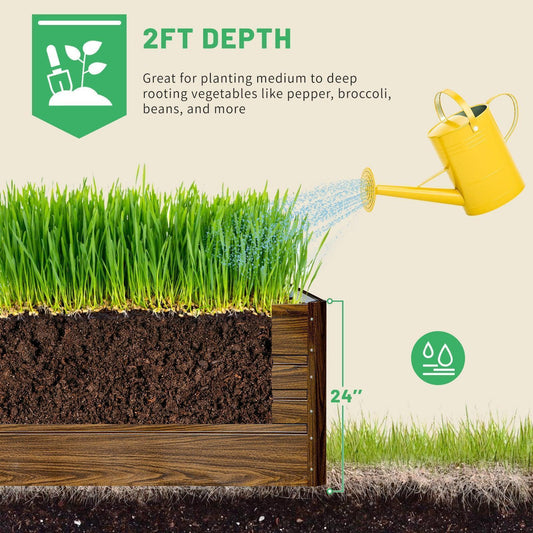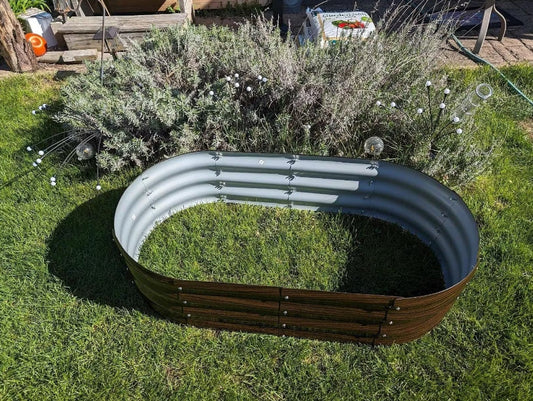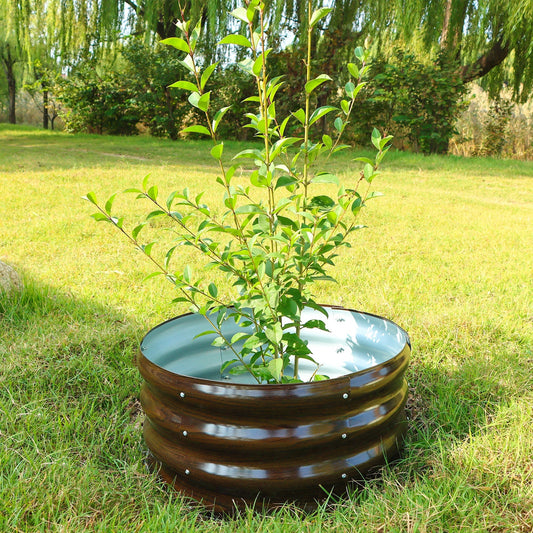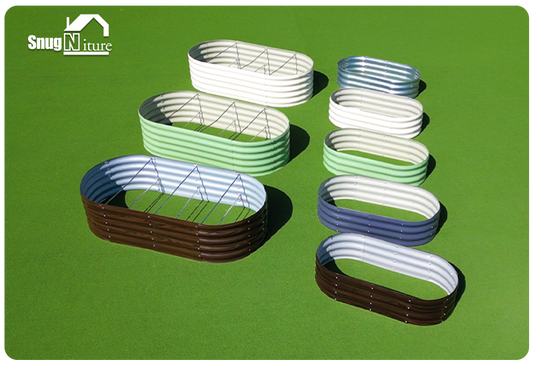Metal Raised Garden Beds Unveiled Pros and Cons You Should Know
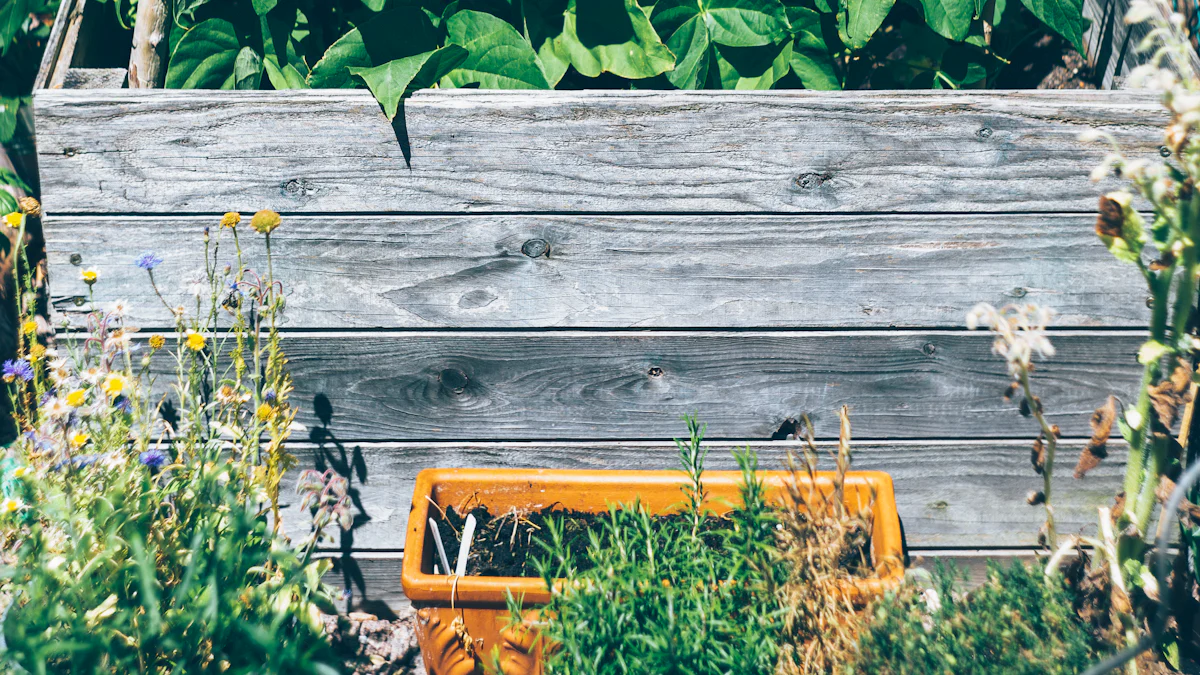
Have you noticed how metal raised garden beds are popping up in gardens everywhere? They’ve become a favorite for modern gardeners, and it’s easy to see why. These beds are durable, easy to maintain, and perfect for small spaces like patios or rooftops. Plus, they’re great for raised bed gardening, offering better drainage and healthier soil. But before you dive in, it’s important to weigh their pros and cons. After all, every gardening choice comes with its advantages and disadvantages. For those passionate about sustainability, metal beds also stand out—they’re recyclable and built to last for decades.
What Are Metal Raised Garden Beds?
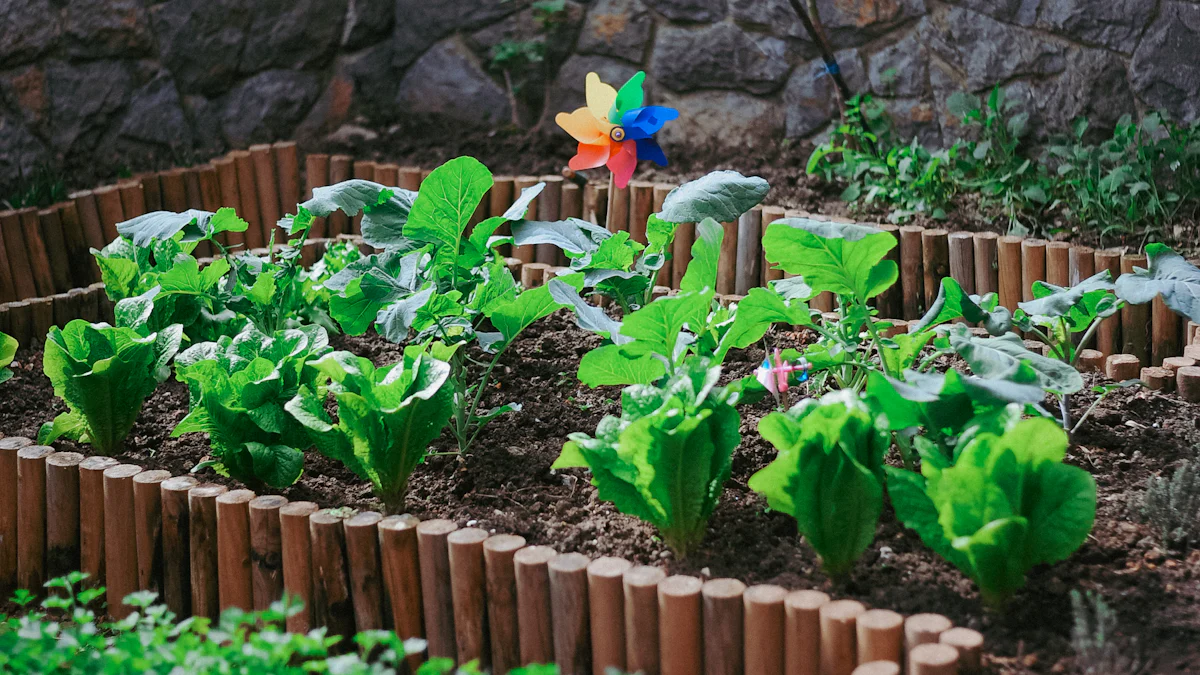
Definition and Purpose
Metal raised garden beds are elevated planting structures made from durable metals like galvanized steel. They’re designed to create a controlled environment for growing plants, making gardening more accessible and efficient. You can use them to grow vegetables, herbs, or flowers in spaces where traditional gardening might not work, like patios or areas with poor soil. These beds also help you manage soil quality, drainage, and pests more effectively.
If you’re looking for a modern, long-lasting solution for your garden, metal raised garden beds are a great choice. They combine functionality with style, making them a favorite for both beginner and experienced gardeners.
Common Materials Used in Metal Raised Garden Beds
The most popular material for these beds is galvanized steel. It’s rust-resistant, durable, and safe for growing food since it doesn’t leach harmful chemicals into the soil. Galvanized raised beds can handle harsh weather conditions, so they’re perfect for outdoor use.
Other materials include corrosion-resistant steel and corrugated metal. Corrosion-resistant steel prevents rusting and lasts for years, while corrugated metal is lightweight and easy to install. Here’s a quick comparison of the common metals:
Metal Type |
Characteristics |
|---|---|
Galvanized Steel |
Rust-resistant, durable, safe for food growing |
Corrosion-resistant Steel |
Withstands harsh weather, prevents rusting |
Corrugated Metal |
Lightweight, easy to install, rust-resistant |
Key Features That Set Metal Beds Apart
Metal raised garden beds stand out for their durability and low maintenance. Unlike wooden beds, they don’t rot or degrade over time. You won’t need to worry about sealing or staining them either. They’re also less inviting to pests like termites and rodents, which means fewer headaches for you.
Another unique feature is their heat retention. Metal conducts heat well, which can extend your growing season by keeping the soil warm. Plus, galvanized raised beds often come with built-in drainage systems, helping you maintain the right soil moisture and prevent erosion.
Here’s how metal beds compare to wooden ones:
Feature |
Metal Raised Garden Beds |
Wooden Raised Garden Beds |
|---|---|---|
Durability |
Long-lasting, rust-resistant, does not rot |
Can rot and degrade over time |
Maintenance |
Low maintenance, no sealing or staining required |
Requires regular maintenance |
Pest Resistance |
Less inviting to pests like termites and rodents |
More susceptible to pests |
Heat Retention |
Good conductor of heat, extends growing season |
Poor heat retention |
Design Versatility |
Modular and customizable designs |
Limited design options |
Aesthetic |
Sleek, modern look |
Traditional, may not suit modern designs |
If you want a sleek, modern garden setup that’s built to last, metal raised garden beds are hard to beat.
Pros of Metal Raised Garden Beds
Durability and Longevity
When it comes to durability, metal raised garden beds are in a league of their own. These beds can last for decades—typically 20 to 30 years—far outlasting wood or plastic options. Unlike wood, which can rot, or plastic, which may crack under harsh weather, metal beds stay strong and reliable. Galvanized raised beds, in particular, resist rust and corrosion, making them perfect for outdoor use.
Here’s a quick comparison of how different materials stack up:
Material |
Durability |
Lifespan |
|---|---|---|
Metal |
High |
Decades |
Wood |
Moderate |
Limited |
Plastic |
Moderate |
Variable |
If you’re looking for a long-term investment that won’t need constant replacement, metal raised garden beds are a smart choice. Their durability ensures you’ll enjoy gardening without worrying about wear and tear.
Aesthetic Appeal
Metal raised garden beds don’t just perform well—they look great too. Their modern and stylish designs can elevate your garden aesthetic, giving your outdoor space a sleek, polished look. Whether your garden leans toward a classic or contemporary vibe, these beds fit right in.
Some design elements that make them stand out include:
Modern and stylish designs
Versatility for various garden styles
The ability to enhance the elegance of outdoor spaces
With galvanized raised beds, you get both form and function. They’re not just practical; they’re a beautiful addition to any garden.
Pest and Weed Control
Metal raised garden beds offer several benefits when it comes to keeping pests and weeds at bay. Unlike wood, metal doesn’t rot or warp, so you won’t have to deal with insect damage. The sturdy structure also makes it harder for pests like rodents to invade your plants.
Weeds are less of a problem too. The improved soil quality and drainage in these beds create an environment where weeds struggle to thrive. Plus, the raised design makes it easier for you to spot and remove any unwanted growth.
Here’s why they’re so effective:
Better drainage for healthier soil and fewer weeds
A raised design that reduces bending and makes gardening easier
With these benefits, you’ll spend less time battling pests and weeds and more time enjoying your garden.
Ease of Maintenance
Metal raised garden beds are incredibly easy to maintain, making them a favorite among busy gardeners. Unlike wooden beds, which require regular sealing or staining to prevent rot, metal beds hold up well without much effort. You won’t have to worry about pests like termites or rodents damaging the structure either. Their sturdy design keeps them in great shape for years with minimal upkeep.
Cleaning these beds is a breeze. A quick rinse with water or a wipe-down with a damp cloth is usually all it takes to keep them looking fresh. If you choose galvanized raised beds, you’ll appreciate their rust-resistant coating, which reduces the need for frequent inspections or repairs.
Another bonus? Metal beds are easy to assemble. Most come with pre-drilled holes and simple instructions, so you can set them up in no time. Once installed, they stay put, even in harsh weather conditions. This means less time spent on repairs and more time enjoying the benefits of your garden.
Better Drainage for Healthier Plants
Good drainage is one of the biggest pros of metal raised garden beds. These beds prevent water from pooling, which helps you avoid common issues like root rot. Proper drainage also ensures your plants get enough oxygen, keeping their roots healthy and strong.
Here’s how better drainage benefits your plants:
It prevents soil from becoming waterlogged, reducing the risk of root damage.
It promotes oxygen flow to the roots, which is essential for plant growth.
It helps the soil warm up faster in spring, giving you a head start on the growing season.
In fact, well-drained soil creates the perfect balance of water and air circulation. This balance is crucial for plant health, especially in enclosed containers like raised beds. With galvanized raised beds, you’ll notice your plants thriving thanks to the improved soil quality.
Eco-Friendliness and Sustainability
If you’re looking for an eco-friendly gardening option, metal raised garden beds are a fantastic choice. They’re made from recyclable materials like aluminum or steel, which means they can be repurposed at the end of their lifespan. Choosing beds made from recycled metals can further reduce your carbon footprint.
These beds are also durable, so you won’t need to replace them as often as wooden ones. This longevity reduces waste and supports sustainable gardening practices. Plus, they don’t require chemical treatments to prevent rot, unlike wood. This makes them safer for the environment and your plants.
Another sustainable feature is their efficient water use. The design of metal beds minimizes water waste, helping you conserve this precious resource. By investing in metal raised garden beds, you’re not just improving your garden—you’re also making a positive impact on the planet.
Drawbacks of Metal Raised Garden Beds
Higher Initial Cost
One of the biggest drawbacks of metal raised garden beds is their higher upfront cost. Compared to wooden or plastic options, metal beds often come with a steeper price tag. This is because they’re made from high-quality materials like galvanized steel or corrosion-resistant metals. These materials are designed to last for decades, but that durability comes at a cost.
Here’s why the initial investment is higher:
The use of premium materials, especially those treated to resist rust and corrosion.
Specialty metals, like galvanized steel, add to the price.
While wooden beds are cheaper upfront, metal beds offer long-term savings due to their durability and low maintenance.
If you’re on a tight budget, the cost might feel like a hurdle. However, it’s worth considering the long-term benefits. Metal beds require less upkeep and last much longer, which can offset the initial expense over time.
Heat Retention in Direct Sunlight
Metal raised garden beds have excellent thermal conductivity, which means they absorb and distribute heat effectively. While this can be a pro in cooler climates, it can become a challenge in hot weather. The metal can cause the soil to heat up quickly, leading to faster evaporation of moisture. This can stress plant roots and reduce their ability to absorb nutrients.
Here’s how heat retention might affect your plants:
Stress on plant roots, especially in sensitive species.
Potential heat stress, which can stunt growth.
To manage this issue, you can take a few simple steps:
Add organic matter to the soil to improve insulation and retain moisture.
Use shade structures to protect the beds during the hottest parts of the day.
Choose heat-tolerant plants that thrive in your local climate.
By making these adjustments, you can minimize the impact of heat retention and keep your plants healthy.
Potential for Rust or Corrosion
Although galvanized raised beds are treated to resist rust, they’re not completely immune. Over time, exposure to moisture and acidic soil can lead to corrosion. This is especially true if the protective zinc coating wears off. Rust not only affects the appearance of your beds but can also compromise their structural integrity.
Here’s what you can do to prevent rust:
Avoid using soil with high acidity. Aim for a neutral pH to reduce the risk of corrosion.
Regularly inspect your beds for signs of wear and tear.
Consider applying an additional protective coating to extend the lifespan of the metal.
While rust is a potential drawback, it’s manageable with proper care. Galvanized raised beds are still a durable and reliable choice for most gardeners.
Safety Concerns (e.g., sharp edges or material toxicity)
When working with metal raised garden beds, you’ll want to keep a few safety concerns in mind. While these beds are sturdy and practical, they can come with some risks that you should address to keep your garden safe and enjoyable.
First, watch out for sharp edges. Some metal beds, especially those made from corrugated steel, might have unfinished edges that could cause cuts or scrapes. To avoid this, check the edges before assembly. You can also cover them with protective edging or tape for added safety.
Another thing to consider is the potential for corrosion. Over time, exposure to moisture and soil can cause the metal to degrade. This might release harmful substances into the soil, which could affect your plants. To minimize this risk, choose galvanized or corrosion-resistant metals. Regularly inspect your beds for signs of rust and take action if you notice any.
Chemical leaching is another concern. Some treated or painted metals might release chemicals into the soil, especially if the coating wears off. This could harm your plants and even make them unsafe to eat. To prevent this, opt for untreated or food-safe materials when selecting your raised beds.
Lastly, keep an eye on heat absorption. Metal beds can get quite hot in direct sunlight, which might elevate soil temperatures and stress plant roots. Adding mulch or shade cloth can help regulate the temperature and protect your plants.
By addressing these safety concerns, you can enjoy the benefits of metal raised garden beds without worry.
Limited Airflow to Soil Compared to Other Materials
Metal raised garden beds offer many advantages, but they do have some cons, like limited airflow to the soil. Unlike wooden or plastic beds, metal doesn’t allow air to pass through its walls. This can restrict the natural exchange of gases in the soil, which is essential for healthy plant roots.
Why does this matter? Well, soil needs oxygen to support the microorganisms that help plants grow. Without proper airflow, the soil might become compacted, reducing its ability to retain water and nutrients. This could lead to slower plant growth or even root rot in extreme cases.
To counter this drawback, you can take a few simple steps. First, use loose, well-aerated soil when filling your beds. Adding organic matter like compost or peat moss can improve soil structure and promote better airflow. You can also aerate the soil regularly by gently loosening it with a garden fork or trowel.
Another tip is to avoid overwatering. Excess water can fill the air pockets in the soil, further limiting oxygen flow. By watering only when needed, you’ll keep the soil balanced and healthy.
While limited airflow is a minor drawback, it’s easy to manage with the right techniques. With a little care, your plants will thrive in their metal raised garden beds.
Comparison with Other Raised Garden Bed Materials
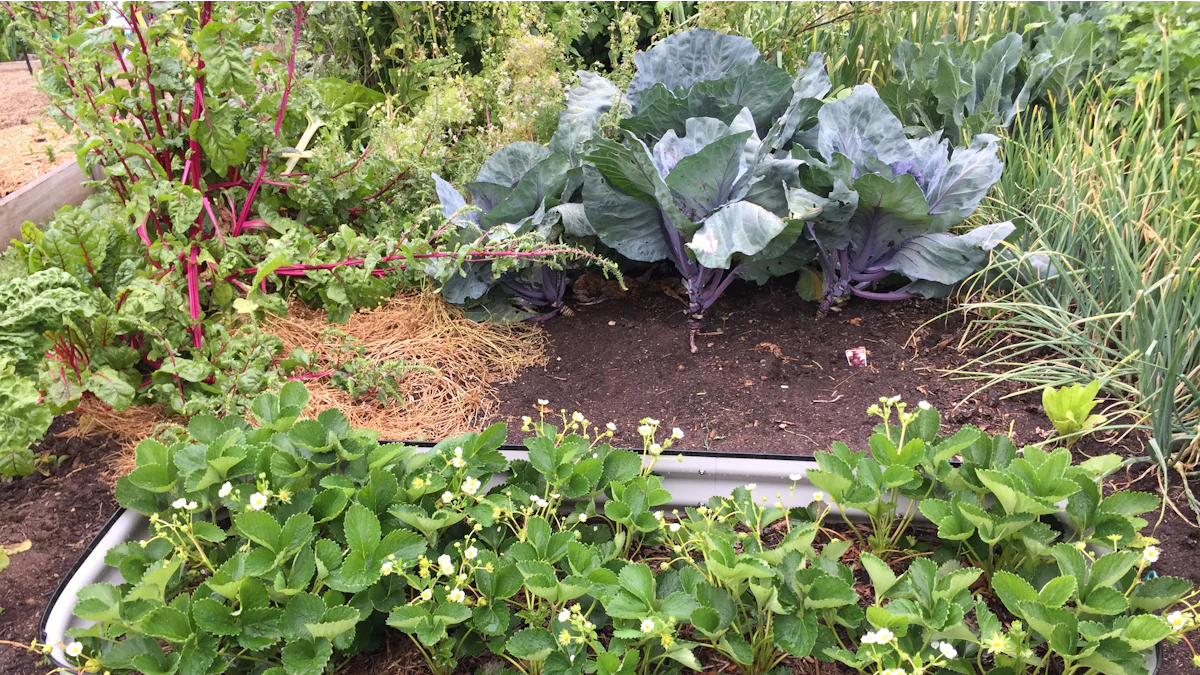
Metal vs. Wood
When comparing metal and wooden raised beds, durability is the first thing you’ll notice. Metal raised garden beds resist rot and insect damage, lasting 10 to 20 years or more. Wooden raised beds, on the other hand, are more vulnerable to pests and decay. Depending on the type of wood, they typically last 5 to 15 years.
Feature |
Metal Raised Beds |
Wooden Raised Beds |
|---|---|---|
Durability |
More durable, resist rot and insects |
Susceptible to rot and pest damage |
Lifespan |
10-20 years or more |
5-15 years depending on wood type |
Maintenance |
Requires almost no maintenance |
Requires regular sealing and treatment |
Metal beds require almost no upkeep. You can set them up and forget about them. Wooden beds, however, need regular sealing or treatment to prevent warping and rot. If you’re looking for a low-maintenance option, metal is the way to go. But if you love the natural look of wood and don’t mind the extra care, wooden raised beds might suit your style better.
Metal vs. Plastic
Plastic beds are lightweight and affordable, making them a popular choice for beginners. However, they don’t hold up as well as metal beds. Over time, plastic can crack or fade, especially when exposed to harsh sunlight. Metal beds, by contrast, stay strong and maintain their appearance for decades.
Another key difference is sustainability. Metal beds are often made from recyclable materials, while plastic beds contribute to environmental waste when they break down. If you’re aiming for an eco-friendly garden, metal is the better choice.
That said, plastic beds are easier to move around. If portability is important to you, plastic might be worth considering. But for long-term durability and sustainability, metal beds come out on top.
Metal vs. Concrete or Stone
Concrete and stone beds are incredibly sturdy and can last a lifetime. However, they’re heavy and difficult to install. Metal beds offer a more practical alternative. They’re durable yet lightweight, making them easier to set up and move if needed.
In terms of cost, concrete and stone beds can be expensive. Metal beds provide a more budget-friendly option without sacrificing longevity. Plus, metal beds have a sleek, modern look that complements contemporary garden designs, while stone beds lean toward a more traditional aesthetic.
If you want a permanent structure and don’t mind the effort, stone or concrete might work for you. But if you prefer flexibility and ease of installation, metal raised garden beds are a fantastic choice.
Tips for Maintaining Metal Raised Garden Beds
Preventing Rust and Corrosion
Keeping your metal raised garden beds rust-free is easier than you might think. A few simple steps can go a long way in preserving their durability and appearance.
Start by choosing galvanized raised beds. The zinc coating on these beds offers excellent rust resistance, even in damp conditions.
Ensure proper drainage by drilling small holes at the bottom of the bed. This prevents water from pooling, which can lead to corrosion.
Line the interior with geotextile fabric. This creates a barrier between the metal and the soil, reducing moisture contact.
You can also take extra precautions:
Use a protective lining or spray the metal with a waterproofing solution.
Store your beds in a dry, secure place during winter to minimize exposure to moisture.
By following these tips, you’ll extend the lifespan of your beds and maintain their structural integrity.
Managing Heat Retention
Metal beds are great at retaining heat, but in hot weather, this can become a challenge for your plants. Luckily, there are ways to manage soil temperature and keep your garden thriving.
Add organic matter like compost or mulch to the soil. This helps insulate it, retain moisture, and buffer against temperature swings.
Place your beds strategically. Position them where they get adequate airflow, and consider partial shade to reduce direct sunlight exposure.
Choose heat-tolerant plants. Varieties adapted to warm climates can handle higher soil temperatures without stress.
These adjustments will help you create a balanced environment for your plants, even during the hottest months.
Regular Cleaning and Inspection
A little maintenance goes a long way in keeping your galvanized raised beds in top shape. Regular cleaning prevents rust and keeps the beds looking fresh. Use a mild detergent and rinse thoroughly, making sure to dry the surface completely.
At the end of each growing season, clear out debris like spent plants and weeds. Disinfect the frames with a mild bleach solution to stop pathogens from spreading. Don’t forget to inspect the beds for signs of wear, such as scratches or rust spots. Applying a protective coating can help extend their lifespan.
By staying on top of cleaning and inspections, you’ll ensure your beds remain a reliable and attractive part of your garden for years to come.
Choosing the Right Soil and Plants
Choosing the right soil and plants for your metal raised garden beds can make all the difference in your gardening success. The good news? These beds work well with a variety of options, so you can tailor them to your needs.
Start with the soil. You’ll want a mix that’s loose, nutrient-rich, and well-draining. A combination of garden soil, compost, and peat moss works wonders. This mix ensures your plants get the nutrients they need while preventing water from pooling. If you’re growing vegetables, consider adding organic matter like aged manure or worm castings for an extra boost.
Now, let’s talk about plants. Metal beds retain heat, which can be a blessing or a challenge depending on what you grow. Heat-tolerant plants like marigolds, oregano, thyme, and rosemary thrive in the warmer edges of the bed. Fruiting plants such as tomatoes and peppers also love the extra warmth, but keep an eye on them in hot climates. Sensitive plants like lettuce and carrots prefer cooler spots, so plant them in shaded areas of the bed to avoid heat stress.
For long-term planting, perennials are a great choice. Metal beds are durable, making them perfect for plants that stay in the same spot year after year. Herbs like sage and green beans also do well, offering a mix of beauty and practicality.
When planning your garden, think about placement too. Group plants with similar water and sunlight needs together. This makes it easier to care for them and ensures they thrive in their environment.
By choosing the right soil and plants, you’ll create a garden that’s not only productive but also a joy to maintain.
Metal raised garden beds offer a unique blend of durability, accessibility, and sustainability, making them a standout choice for gardeners. Their benefits, like improved drainage, better soil quality, and long-lasting materials, cater to various gardening needs. Whether you’re working with limited space or aiming for eco-friendly practices, these beds can transform your garden.
However, it’s essential to consider the drawbacks. In hot climates, excessive heat retention can stress plants, and the potential for rust or chemical leaching requires attention. By weighing these pros and cons, you can decide if metal raised garden beds align with your goals. With the right care, they can elevate your gardening experience.



